Before we launch into today’s festivities, a couple of quick announcements. First, all of us here at Author! Author! are wafting good wishes toward science fiction author Orson Scott Card, who suffered a mild stroke last Saturday. Here’s to a speedy recovery, OSC!
Second, a heads-up for Seattle residents and those lucky enough to live in her relatively snow-free environs: Heidi Durrow, author of The Girl Who Fell from the Sky, will be giving a reading tonight at the Northwest African-American Museum (2300 S. Massachusetts St.), as well as signing her book at Costco (4401 4th Avenue S.) on Friday at 12:30 p.m. and reading at Third Place Books (17171 Bothell Way NE, Lake Forest Park) on Saturday at 6:30 p.m. I shall be at the Saturday night event, so please do come up and introduce yourself!
In other news, nominations for the Bloggies — which celebrate precisely what you think they do — are now open, and shall remain open through this coming Sunday, January 16th. So if anybody out there should happen to admire any particular blog, this would be a lovely time to express that sentiment through a nomination, if you catch my drift. Only the most-nominated blogs in any category (say, art/craft or topical) will proceed to the judging round, so if you have an opinion on the subject, now would be the time to weigh in about any blog you’d found particularly helpful within the last year.
I just mention. Back to the business at hand.
Earlier in this series, incisive reader Bruce (seconded by sharp-eyed reader Elizabeth) pointed out an issue that had somehow so far slipped between the cracks of Formatpalooza. Ahem:
The first page of my novel begins with a dateline. How would you treat it? As a typical dateline, as in a mag or newspaper? As a header?
or as something in-between?
At first, I must admit, I was a trifle nonplused by this question. Had we not discussed the issue of inserting articles, letters, and journal entries earlier in this series and did not that jolly little monologue include discussion of how to include a dateline?
Well, it did and it didn’t, as I learned upon going back and doing a spot of re-reading. That earlier post did indeed show a couple of options for including a dateline for an article, letter, or diary entry imbedded within a non-academic manuscript. (For guidelines covering this kind of long quote in academic work, please see that previous post.) One could introduce the relevant date in the text just before the excerpted bit:
That would work in either a fiction or nonfiction manuscript. Nonfiction writers, however, also enjoy the option of using a boldfaced subheading. This format is especially popular for excerpting newspaper articles, as it would more closely resemble the way a reader might find it in a published book. Take a gander:
Doesn’t leave much doubt about when ol’ Nellie wrote that journal entry, does it? If this same entry were to appear in a novel manuscript, however, the boldfacing would not be appropriate.
Why the dichotomy? Pull out your hymnals and sing along now: in a novel manuscript, nothing whatsoever should be in boldface or underlined. In a nonfiction manuscript, only subheadings may be in boldface.
Thus, in a novel, Nellie’s diary entry would look like this on the page:
Everybody clear on that? I want to make certain, because as we saw in our last Formatpalooza post, in the welter of manuscript-formatting information out there, it’s very, very easy for an aspiring writer to conflate what would be appropriate for a dateline in one context — in this case, mid-chapter in a fiction or nonfiction manuscript — with what is called for in another.
Say, if the date, time, and/or place designation were opening a chapter, or even, as Bruce and Elizabeth would like to do, the book.
I have good reason to be cautious: if an unwary writer were simply to type dateline + manuscript format into Google, much of what would pop up in the first page would be either inapplicable or wrong. Actually, I just did it, and Result #6 was a link to Bruce’s question on this site. It also turned up a self-styled expert ordering an eager questioner to use underlining instead of italics, which is flatly incorrect for a book manuscript. Not entirely surprisingly, the expert didn’t bother to mention — and perhaps was unaware — that standard format for short stories, articles, and books is different, and thus it’s absurd to pretend that all writing, anywhere, anytime should be formatted identically for submission.
The moral here: before you accept ANY formatting advice, make sure it is specifically aimed at your type of writing. If a list of guidelines claims, either by positive assertion or omission, to be universally applicable for all manuscripts, run, don’t walk, in the opposite direction. And perhaps this goes without saying, but if you don’t know what precisely makes the person giving the advice an expert, ask follow-up questions, rather than believing — as an astonishingly high percentage of aspiring writers seeking advice online seem to do — that all online sources are equally credible.
It’s just not true, and trying to follow all of that wildly disparate advice simultaneously will only drive you nuts. Seriously, it’s a waste of your valuable time and energy. Find a credible source for your particular type of writing, cross-check what that source says with agency and publishing house submission guidelines before you even consider following the source’s advice, and don’t allow yourself to be distracted by every new suggestion you see online.
Especially if the source leaves you guessing whether the rule being touted is intended to apply to short story submissions (as, say, underlining to indicate italics would be) or book-length works (as in the imperative never to underline anything at all, under any circumstances). Just because the words manuscript, submission, and writing may be applied to both of these wildly different venues does not mean that the expectations are identical in each.
This is not a guessing game, after all. Actual standards do exist — they are merely industry-specific.
My point is — I honestly have had one lurking in the background throughout those last few paragraphs — one of the perennial problems faced by any aspiring writer trying to glean information online is the necessity for boiling complex concepts down to super-simple search terms. It’s led, unfortunately, to a tendency for definitional creepage.
You know what I’m talking about, right? It’s when a key word or phrase is ripped out of context often enough and used to mean other things in other venues that it comes to lose its specificity — and, eventually, its utility as a search term. Unfortunately, on the writing grapevine, definitional creepage is practically as common as complaints about how hard it is to land an agent in these trying times.
We saw a great example in our last post: a questioner used the term teaser to refer to a brief scene placed at the beginning of a novel, even though it would fall temporally later in the plot, in order to draw the reader into the book’s central conflict and open with action. It’s a comprehensible use of the word, but more specific uses, a teaser is everything from a promotional offer used in advertising to a rhetorical question used at the beginning of a newspaper or magazine article to tempt the reader into reading on to a theatrical curtain draped across the top of the proscenium arch to mask the flies and, along with the tormentors, provide a fabric frame for a stage.
And that’s not even counting the (avert your eyes, children) sexual definitions. The mind positively reels at the number of websites a curious writer might turn up by trying to find a little basic guidance on how to write one.
Think I’m digressing again? Au contraire, mon frère, because definitional creepage has almost certainly rendered it significantly more difficult for today’s brave questioners to find credible answers to this legitimate and serious formatting question.
Why? Well, primarily because not every date designation in writing is a dateline (or, in its more common usage, date line). In journalism, a dateline is the bit at the beginning of the article that tells the reader the date and place from which the news within the article was reported, usually presented in all capital letters: SEATTLE, JANUARY 12. Its purpose is not merely to indicate where the reporter was within the space-time continuum when she filed the story, but to enable readers to tell yesterday’s news from an article filed three weeks ago.
But that’s not its old definition, is it? Those of you addicted to looking things up will also be delighted to know that a date line is also how some earth scientists refer to the 180th meridian of longitude, better known to the rest of us as the International Date Line.
Now, clearly, Bruce wasn’t inquiring about the hypothetical dividing point where, by international agreement, a traveler moves from one day to the next. As a reasonable, sane human being, this definition did not even occur to me when I first read his question. Search engines, however, are not human beings, capable of considering the larger context, but must instead rely solely upon the search terms fed into them.
Yes, even extremely well-designed search engines. See the potential problem?
Why bring all of this up, rather than simply answering the original question? Two reasons. First, as an explanation and apology to all of the future web searchers who will undoubtedly end up on this page after having fed the term dateline or date line into their preferred search engines. Next time, you might want to add an extra term or to, to provide specific context.
Second, I’m REALLY glad that this term showed up in today’s question, because definitional creepage appears to be a factor in approximately 1 out of every 10 questions the Author! Author! comments. A lot of good writers out there seem to be frustrated by the results of insufficiently specific search terminology — and downright annoyed by the plethora of advice about ostensibly the same subject, when so many of the advice-givers are actually talking about different matters.
Didn’t think I could bring that diatribe full circle, did you? I’m a professional; don’t try this at home.
Let’s make things easy on the next aspiring writer looking for an answer to the question that Bruce and Elizabeth were kind and brave enough to bring forward for discussion by labeling the answer as clearly as humanly possible. Please, if you can think of other ways you might conceivably search for this information, mention it in the comments, so it can turn up in future web searches.
How to present a date and/or time at the beginning of a chapter or manuscript
As is often the case, the lucky writer has a couple of formatting options, both with concomitant advantages and disadvantages. One could, as we saw in our last post, simply use the date and/or time as the subtitle on page 1:
Or even as the title:
There is, however, a third and quite popular option: insert something that does in fact resemble a dateline in a newspaper article. Obviously, though, one would not want to format it exactly like a dateline — one should not, for instance, present it in all capital letters or substitute it for the necessary indentation at the beginning of the first paragraph of text.
And why wouldn’t we want to do either of those things, campers? Shout it out with me now: because a book manuscript should look like a book manuscript, not like any other kind of manuscript — or like any species of published writing. It is governed by its own rules.
Everybody got that, or should I attempt to wake up that deceased equine for another pummeling?
So how might a savvy writer of books format such a thing? By treating it like any other subheading in a manuscript, placing it where the first line of text would be if the date/time/place designation were not there.
In other words, the space format restrictions at the top of the chapter should not change at all. For fiction, it should look like this:
And for nonfiction, it should look like this:
Do I spot some raised hands waving at me from the ether? “But Anne,” a few thousand sharp-eyed readers point out, “that’s a less efficient use of page space! By adding the date as a subheading, we’ve lost a line of text!”
Quite true, date-lovers: there’s no such thing as a cost-free formatting alteration. While you gain in resemblance to an article’s dateline, you get fewer words per page. For those of you bumping up against that 400-page ceiling, the exchange might not be worth it. However, it’s up to you.
Thanks, Bruce and Elizabeth, for bringing this one up; I think the result has been a valuable addition to Formatpalooza. Thanks, too, to the many, many entrants to our recent Rings True competition whose first pages featured such date, time, and/or place designations; I honestly hadn’t realized that opening a book this way was enjoying a renaissance right now, at least amongst aspiring writers.
Keep those great questions rolling in, everybody. I’m planning to wrap up this series tomorrow, so we can launch back into nice, juicy craft questions over the weekend, but hey, I’m always delighted to clarify a formatting issue.
Keep up the good work!




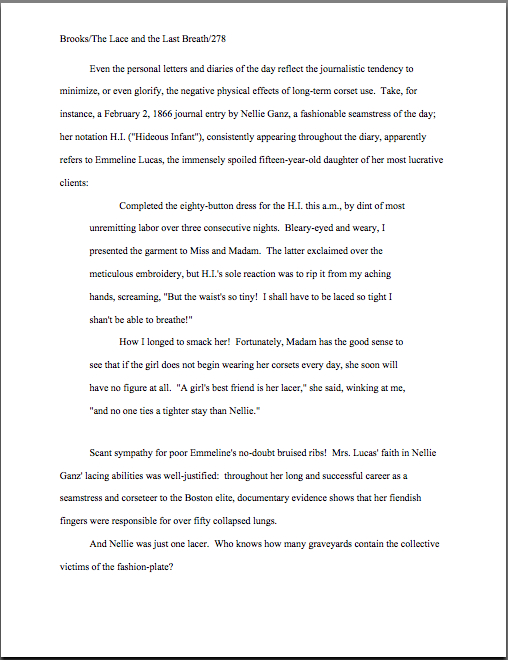
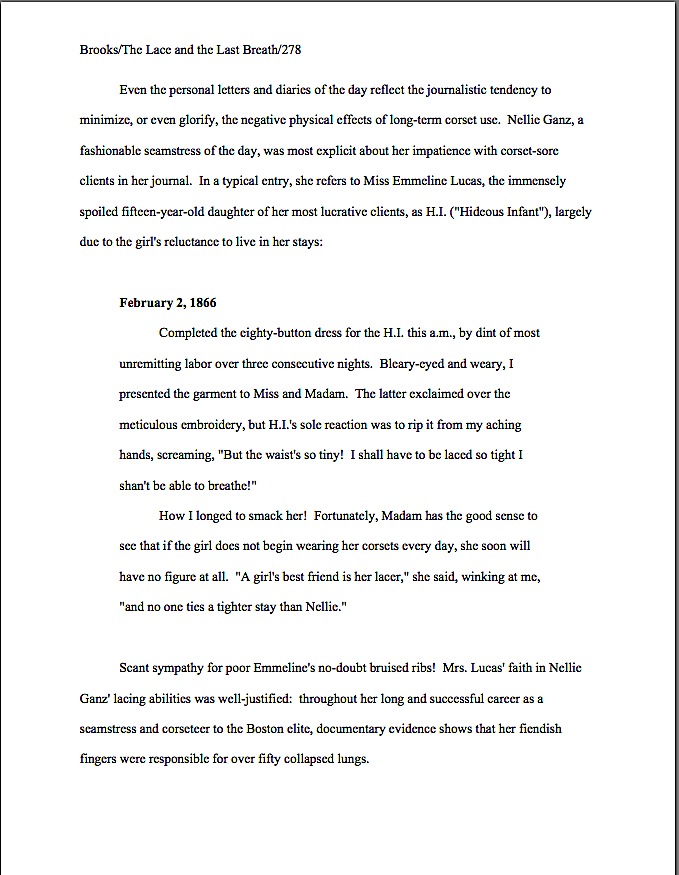
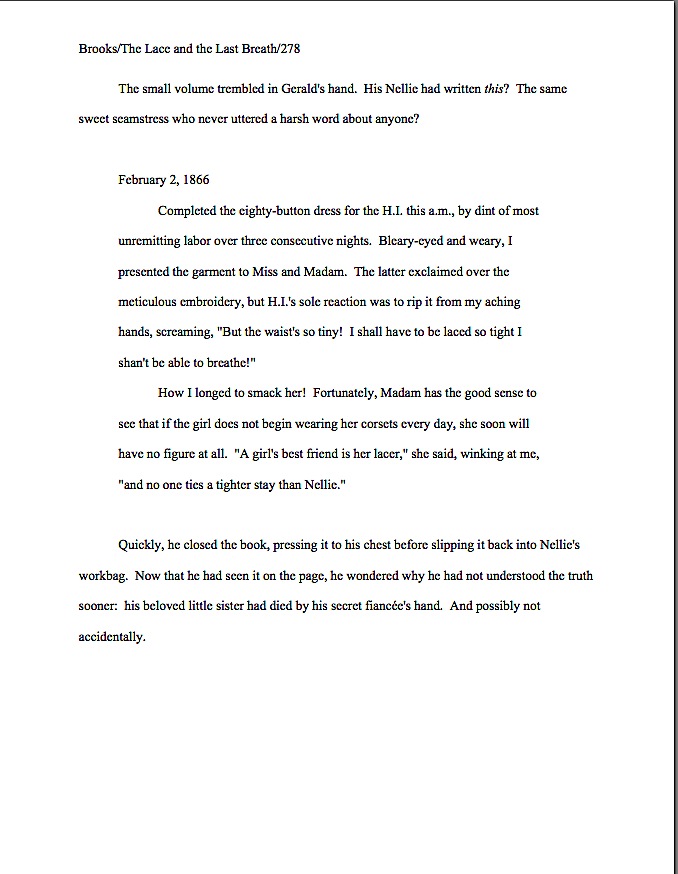
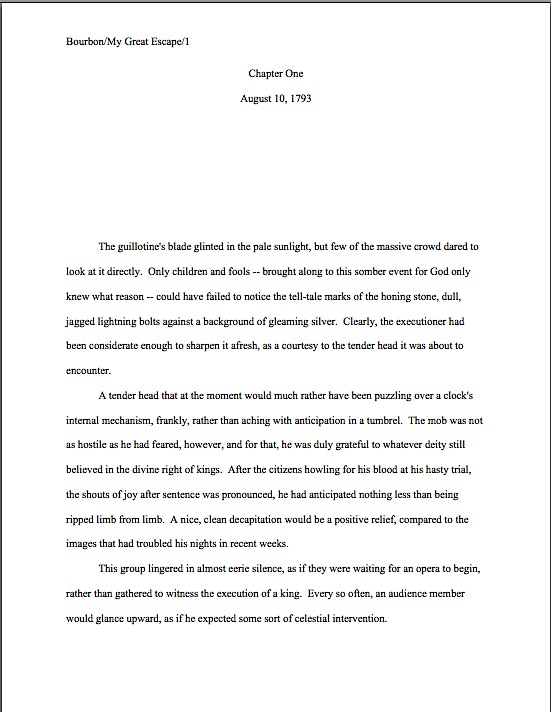
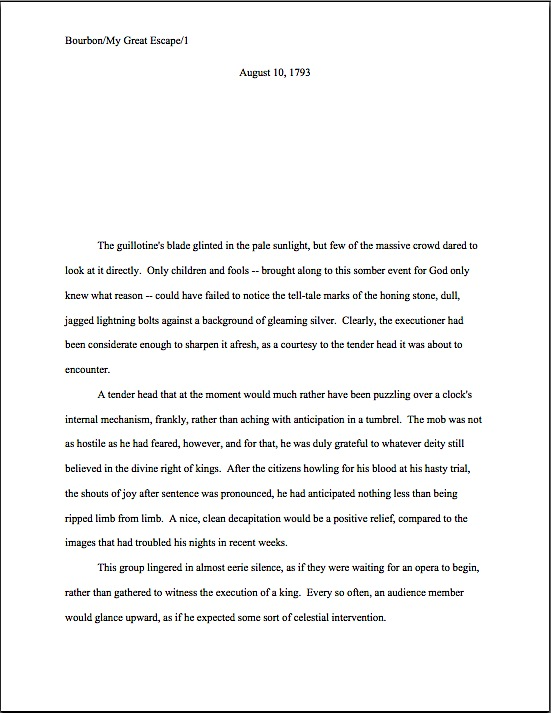


Whew! Thank you, Anne. And thank you, Bruce, for bringing it up in the first place.
It looks like the only thing I messed up was indenting the dateline so it was even with the indent in the paragraph to follow. That’s an easy fix.
Off-topic: my WIP would have been perfect for the latest contest since I don’t know what the hey book category it should go in, but it’s nowhere NEAR ready for your gimlet eye, Anne. And it does NOT begin with a dateline.
Thanks for this post, Anne.
You’re most welcome, both. I honestly was stunned to realize how many people this question might help.